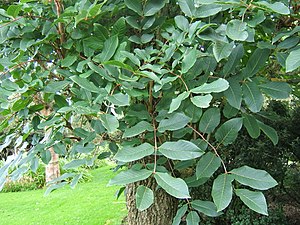Sabiaceae
| Sabiaceae | ||||||||||||
|---|---|---|---|---|---|---|---|---|---|---|---|---|

Pinnate leaves and bark of Meliosma veitchiorum |
||||||||||||
| Systematics | ||||||||||||
|
||||||||||||
| Scientific name | ||||||||||||
| Sabiaceae | ||||||||||||
| flower |
The Sabiaceae are an isolated family of flowering plants (Magnoliopsida). They occur from the tropics from eastern Asia to Malaysia , New Guinea and to the Solomon Islands , in Central and South America .
description
They are evergreen or deciduous, woody plants: trees , shrubs ( Meliosma and Ophiocaryon ) or lianas ( Sabia ).
The mostly alternate and spirally arranged, stalked leaves are simple and composed and are usually leathery. The leaf margins are smooth or serrated. Stipules are missing.
The small flowers stand individually in the leaf axils or they are grouped in axillary or terminal zymous or panicle inflorescences . The mostly hermaphroditic or rarely unisexual flowers are radial symmetry ( Sabia ) or zygomorphic ( Meliosma , Ophiocaryon ) and are usually five-fold. There are usually five (three to seven) free or fused sepals at their base . Usually five (four to seven) free or fused petals are present; they can be the same or the two inner ones are significantly smaller than the outer three. There is only one (the inner) circle with (rarely four) mostly five free stamens or stamens that have grown together with the base of the petals , they are either all fertile ( Sabia ) or three are sterile . There is a small discus. Two or three carpels are partially or completely to upper permanent ovary grown. In every flower there are as many styles as carpels or only one which then has as many scars as carpels.
The arrangement of the sepals, petals and stamens, all of which are on the same radii, is highly unusual.
Mostly flattened and clearly curved stone fruits are formed.
Systematics
The Sabiaceae are very basal within the Eudicotyledons . They may be the sister group of the Proteales , but this is only weakly secured. Should this kinship be confirmed, the family would be placed in an extended order Proteales.
The Sabiaceae family contains only three genera with 80 to 160 species :
- Meliosma flower : It contains about 50 species in Southeast Asia, Central and South America. 29 species occur in China, ten of them only there.
- Ophiocaryon Endl. : It contains about nine tree and shrub species in tropical South America, especially on the Guayana shield and in the Amazon basin .
- Sabia Colebr. : It contains about 30 mostly climbing species in Southeast Asia and Southern Asia. 17 species occur in China, seven of them only there.
swell
- The order of the Sabiales on the AP website . (Section systematics)
- Lixiu Guo & Anthony R. Brach: Sabiaceae. P. 25, online with the same text as the printed work . Wu Zheng-yi, Peter H. Raven, Deyuan Hong (Eds.): Flora of China. Volume 12: Hippocastanaceae through Theaceae. Science Press et al., Beijing et al. 2007, ISBN 978-1-930723-64-1 (sections description, distribution and systematics).
- Description in the flora of Pakistan . (engl.)
Individual evidence
- ↑ Vernon Hilton Heywood (ed.): Flowering plants of the world. Birkhäuser, Basel et al. 1982, ISBN 3-7643-1305-6 , p. 194.
- ↑ Angiosperm Phylogeny Group : An update of the Angiosperm Phylogeny Group classification for the orders and families of flowering plants: APG III. In: Botanical Journal of the Linnean Society. Vol. 161, No. 2, 2009, ISSN 0024-4074 , pp. 105-121, doi : 10.1111 / j.1095-8339.2009.00996.x .
- ↑ Gerardo A. Aymard C., Douglas C. Daly: Two New Species of Ophiocaryon (Sabiaceae) from South America. In: Brittonia. Vol. 58, No. 3, ISSN 0007-196X , 2006, pp. 270-276, doi : 10.1663 / 0007-196X (2006) 58 [270: TNSOOS] 2.0.CO; 2
